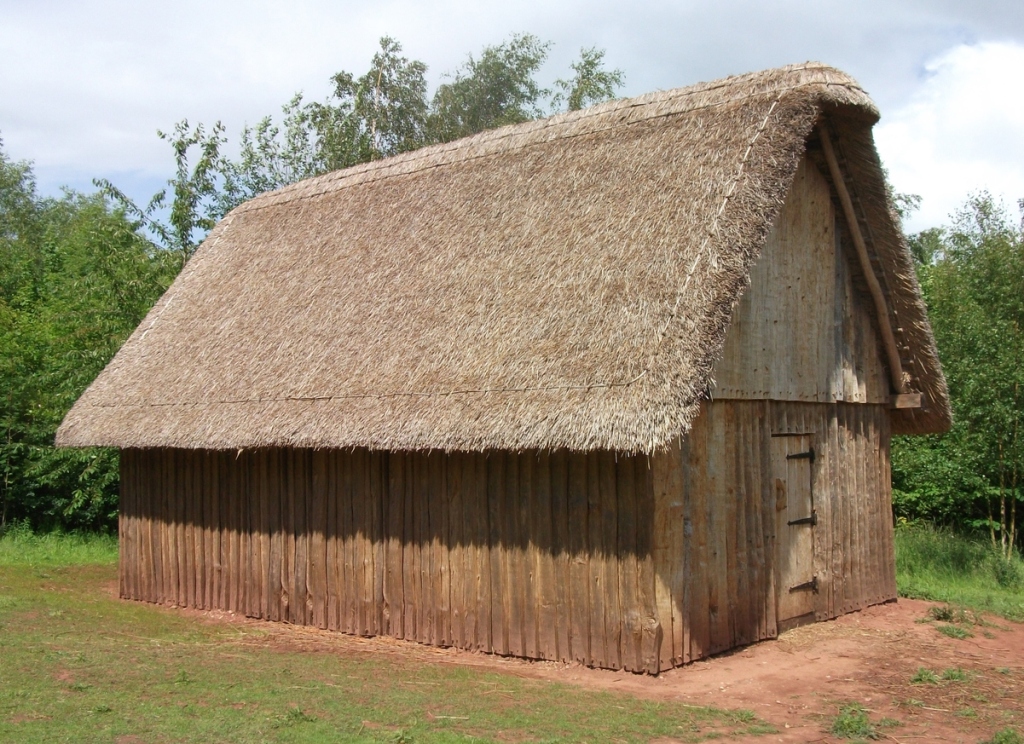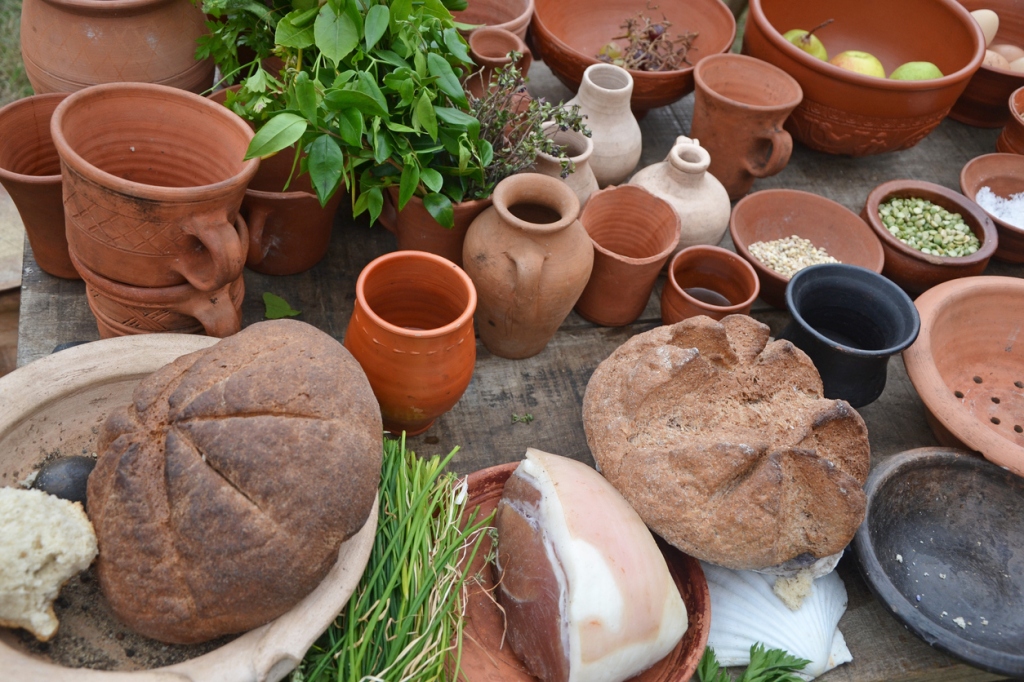What about Anglo-Saxon food and drink?
Earlier in 2021 I was delighted to be asked to speak to the Leeds Symposium on Food, Drink and Health, which develops learning on these aspects of historical research. My session was, of course (!) on the Anglo-Saxon period. The following is based on some of the research I outlined in the session …
There was a rich mead hall culture in Anglo-Saxon times; the mead hall was where the community feasts were held and was a focal point in the village or settlement. ‘Mead’ was the common alcoholic drink made from honey, widely drunk, and especially at communal meals, thus the hall was named after it.
Literary evidence from the 7th or 8th century heroic poem Beowulf (the dating isn’t clear) indicates the riches of the hall and its decoration: ‘tapestries worked in gold glittered on the walls’, ‘eofor-līc scionon ofer hlēor-bergan: gehroden golde’ (‘boar-crests glittered above the helmets adorned with gold’), ‘māđm-æht’ (‘precious treasures’), ‘bēag-gyfa’ (the treasure-giver, or lord/leader/chieftain/king). The feasting and drinking is emphasised in the poem and many Anglo-Saxon words emphasise the importance of mead: ‘medo-ful’ (the mead cup), ‘medo-benc’ (the mead benc), ‘medu-drēam’ (revelry in mead-drinking and feasting).
There would be entertainment during the meal: a scōp would be employed, the poet/musician who entertained with ‘harp and voice’ (not a harp as we know it), and the poetry and story-telling would celebrate both traditional Christian and pagan heroic deeds and values. These narrative poems would honour and glorify the community and unify the society.
The mead hall was the centre of the pre-Anglo-Saxon and Anglo-Saxon village community. It was important as the Witan council, the decision-making meeting, was usually held in the mead hall and often before a feast. Wooden trestle tables were used for eating and could be dismantled or set up easily and quickly for council meetings. It was the focus of village life, eating and drinking together consolidated the stability of the community.

Feasts in the mead hall would be frequent in Anglo-Saxon times, and feast days for the whole community were usually held according to the journey of the moon: commemorating the full moon, new moon, winter solstice, summer solstice, etc.
But the general feasts were not necessarily for everyone in the village. There was a strict hierarchy. The serfs would serve at tables and they and the cooks would eat separately, but they still ate similarly to the thegns, ealdormen and ladies. The ceorls (lower class free men) might be included at table if they held a particular office. But the gebūrs (not in serfdom but keeper of ‘rented’ allotment of land) would not usually be included. The serfs, never.
There would be a ‘high table’ with the cūning/cyning (king/leader), ealdormen and high thegns. At right angles down the hall were the trestle tables for the other nobles. They would be used mainly at noon and evening for communal eating; evening meals in winter were by the light of flaming ‘torches’ in sconces on the wall and hanging cressets filled with oil. There would usually be a huge firepit in the middle of hall.
Whether in the mead hall or in their own houses, most Anglo-Saxons would use wooden bowls, platters and spoons. Everyone had their own knife (a seax or small version of a seax), worn in a leather pouch hanging from their belt at their waist. The wealthier people would have drinking horns for mead and perhaps even glass goblets for wine.
Although there is evidence that the Anglo-Saxons imported dates, figs, raisins and almonds, these would be for the wealthy. But berries and nuts from the hedgerows were plentiful for all. There is also evidence that agriculture changed from primarily arable to grazing land and there would be livestock for meat: eg chicken, cattle, pigs, sheep, ducks. There was often settlement provision and also individual families kept animals for food within their own living quarters: usually pigs and hens, often a cow. So dairy was accessible: milk, butter, cheese, eggs.
Settlements were usually sited near to rivers, for transport rather than drinking as the water was often contaminated (thus beer and ale were popular as well as mead) and fish would be caught, using simple nets, traps and line: trout, salmon, eels, perch, pike and even cockles, scallops and oysters.
On arable land and on the little patches of land next to individual houses, Anglo-Saxons would grow vegetables for the table: leeks (used for health remedies too), beans, peas, turnips, onions. Geburs might rent a patch of land for vegetables.
Arable farming produced spelt, wheat (for bread), rye, barley (for ale), oats (for bread, porridge, cakes). Ancient recipes indicate that bread could be made with ground wheat (flour) and water only, no salt (too precious!) or oil or yeast. Salt was extremely precious because it was the main source of food preservation and often used to mask the bad taste of rotting meat. Herbs were also used for this purpose as well as to flavour and tenderise, for marinades, etc.
There was no sugar, so honey was widely used to sweeten food and drinks (hence honeyed mead). Honeyed bread was a delicacy!
NB further reading:
Ann Hagen (2010) Anglo-Saxon Food and Drink: production, processing and consumption (Anglo-Saxon Books)
Debby Banham (2004) Food and Drink in Anglo-Saxon England (The History Press)
In the next blog, I’ll be looking at how healthy/unhealthy the Anglo-Saxon diet seems to be …
You might like to read more about those times, a fascinating period of English history, in my novel A Shape on the Air. It’s an Anglo-Saxon time-slip mystery available on Amazon at



You must be logged in to post a comment.